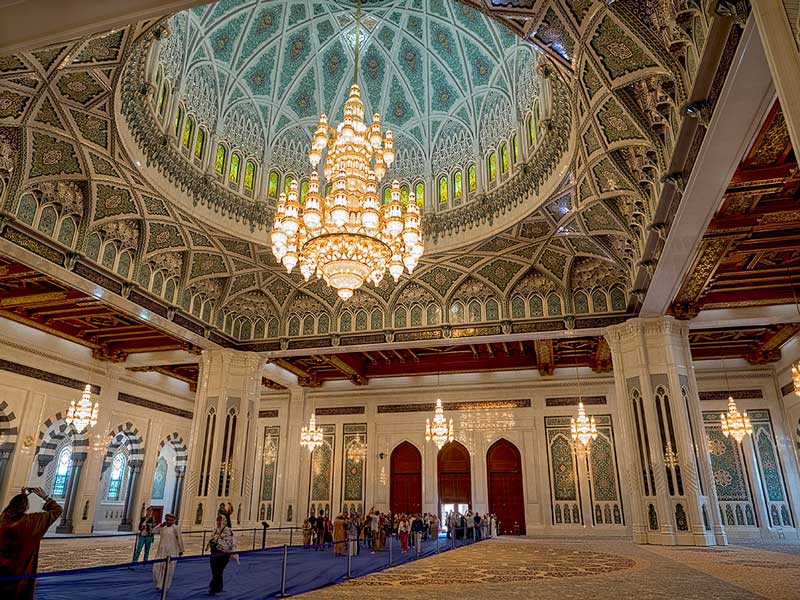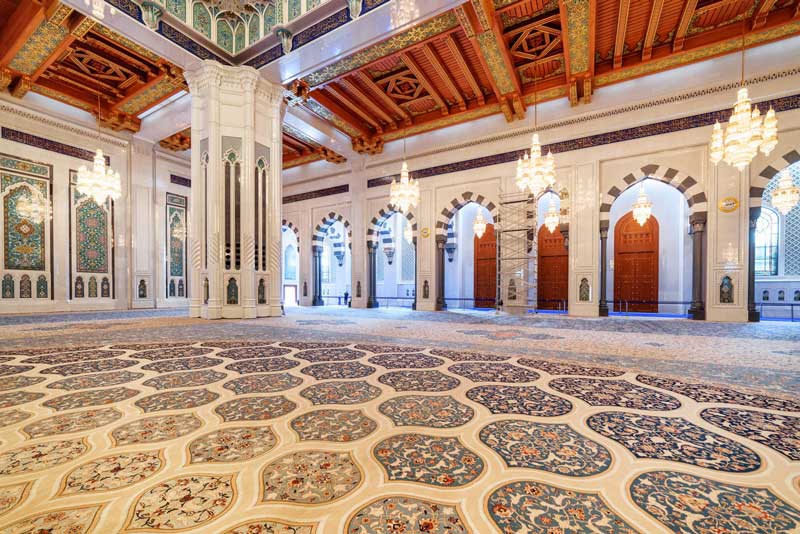
Located in the capital city of Muscat and considered by many as one of the 25 most beautiful and extravagant modern mosques in the world, Sultan Qaboos Mosque is the main mosque and an iconic architectural wonder in the Sultanate of Oman. Built of 300,000 tonnes of Indian sandstone with the capacity to accommodate 20,000 worshippers at a time, the splendid structure is reckoned as the second-largest mosque in the world. It all started in 1992, when Qaboos bin Said, the then Sultan of Oman, who implemented a policy of modernization and ended the international isolation of the country, felt that Oman should have a grand mosque. Accordingly, a competition was arranged in 1993 to select a design for the proposed mosque and construction following the chosen design commenced in December 1994.The grand iconic structure of the mosque, dominating the skyline of the city, reflects a blend of Islamic, Middle Eastern and Omani architectural styles, took six years to build and was inaugurated by the Sultan of Oman on 4 May 2001 in concurrence to celebrate the 30 years of his reign.

Covering a huge area of 416,000 square metres, the enormous Sultan Qaboos Mosque is square in shape, which surrounds the central dome with a total height of 164 feet (50 m). Apart from the beautiful central dome, the other attractive visual feature of the mosque is its 300 feet (90 m) tall main minaret and the 149 feet (45.5 m) tall flanking minarets. The five minarets represent Shahadah, Salah, Sawm, Zakat, and Hajj, the five pillars or compulsory duties of every Muslim and each minaret is equipped with an accessible observation deck, offering a panoramic view of the city.
While the colourful mosaic patterns of the main dome, made with porcelain panels, offer an interesting juxtaposition of the white and grey marble walls, the roof is covered with hand-carved wood, adorned with timber panels, meticulously decorated with calligraphy and arabesques.The outside paved area in the gardens of the mosque can accommodate around 8,000 worshippers, but with the additional space available in the interior courtyard and the passageways, the total capacity of the mosque comes up to 20,000.

The Sultan Qaboos Mosque has separate prayer halls or musalla for men and women. The main prayer hall has the capacity to accommodate more than 6,500 worshippers and the women's musalla, smaller and simpler than the rest of the mosque, can hold around 750 and usually becomes active on Fridays during the Jema’ah prayer. The walls of the main prayer hall are made up of tintless white and ashen grey marble, decorated with intricate murals and geometric designs. While the Verses from the Holy Quran are inscribed in Thuluth script, a script variety of Islamic calligraphy, on a bar connecting the walls with the inner courtyard, Islamic geometric designs are also visible on the corridor archways and the walls of the corridor have the names of Allah in Diwani script, a calligraphic variation of Arabic script.

The 46 feet (14 m) tall and 26 feet (8 m) wide huge chandelier, weighing 8,500 kilograms, hung over the centre of the men's prayer hall, is studded with over 600,000 Swarovski crystals with 24 carat gold plating and more than a thousand halogen bulbs, complete with a dimming system and a small staircase inside it, for maintenance within the chandelier. The chandelier was manufactured by the Italian company Faustig, which took more than four years to complete it. There are 34 smaller chandeliers of the same design, hung in other parts of the mosque.

Another major feature of the interior is the carpet, covering around 4,343 square metre floor area of the main prayer hall, measuring around 230 by 200 feet (70 by 60 m), weighing around 21,000 kilograms and containing 1,700 million knots. It took 600 Iranian women four years to weave the handwoven carpet, produced by Iran Carpet Company (ICC), at the order of the Diwan of the Royal Court of Sultanate and brings together the classical Persian, Isfahan and Kashan design traditions.
About 28 colours in varying shades were used in the whooping carpet, most of which were obtained from traditional vegetable dyes.

Apart from an ablution room with a fountain in the centre of the courtyard of the mosque, the complex contains a library with more than 20,000 books on science, Islamic culture and humanity and a lecture theatre, which holds events open to the public, usually aims to promote inter-faith dialogue. There is also an Islamic Centre, serving free dates, coffee, tea, and other refreshments to the visitors.
Although children under ten years of age are not permitted in the prayer halls, the Sultan Qaboos Grand Mosque is the only mosque in Oman that allows any visitors, irrespective of religion.